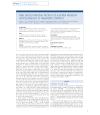-
[Hide abstract]
ABSTRACT: The factor structure of posttraumatic stress disorder (PTSD) symptoms in Euro-American populations has been extensively studied, but confirmatory factor analytic studies from non-Western societies are lacking. Alternative models of DSM-IV symptoms were tested among Rwandan adults (N=465) who experienced trauma during the 1994 genocide. A cluster random survey was conducted with interviews held in Rwandan households. PTSD was assessed with the Posttraumatic Stress Disorder Checklist-Civilian version. Competing models were the DSM-IV, emotional numbing, dysphoria, aroused intrusion, and dysphoric arousal models. Results showed that the emotional numbing, dysphoria, and dysphoric arousal models had almost identical, good fit indices and fit the data significantly better than the other models. The emotional numbing and dysphoric arousal models also exhibited good construct validity. Results suggest that the latent structure of PTSD symptoms in Rwanda are comparable to that found in Euro-American samples, thereby lending further support to the cross-cultural validity of the construct. Copyright © 2015. Published by Elsevier Ltd.Full-text · Article · Mar 2015 · Journal of Anxiety Disorders
samedi 20 février 2016
Risk and protective factors of suicidal ideation and behavior in Rwandan children
- Lauren C Ng · Catherine M Kirk · Frederick Kanyanganzi · Mary C Smith Fawzi · Vincent Sezibera · Evelyne Shema · Justin I Bizimana · Felix R Cyamatare · Theresa S Betancourt[Hide abstract]
ABSTRACT: Background Suicide is a leading cause of death for young people. Children living in sub-Saharan Africa, where HIV rates are disproportionately high, may be at increased risk.AimsTo identify predictors, including HIV status, of suicidal ideation and behaviour in Rwandan children aged 10-17.Method Matched case-control study of 683 HIV-positive, HIV-affected (seronegative children with an HIV-positive caregiver), and unaffected children and their caregivers.ResultsOver 20% of HIV-positive and affected children engaged in suicidal behaviour in the previous 6 months, compared with 13% of unaffected children. Children were at increased risk if they met criteria for depression, were at high-risk for conduct disorder, reported poor parenting or had caregivers with mental health problems.Conclusions Policies and programmes that address mental health concerns and support positive parenting may prevent suicidal ideation and behaviour in children at increased risk related to HIV. © The Royal College of Psychiatrists 2015.Full-text · Article · Jun 2015 · The British journal of psychiatry: the journal of mental science
Inscription à :
Commentaires (Atom)

